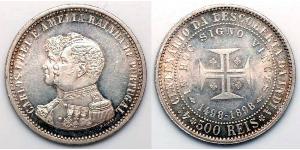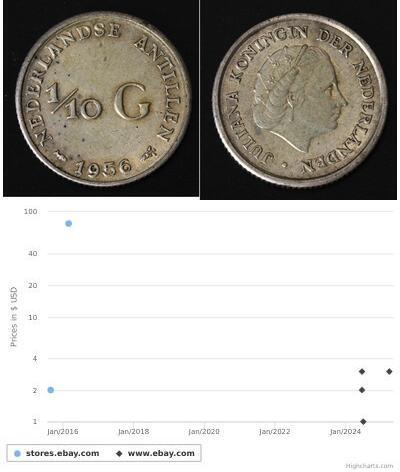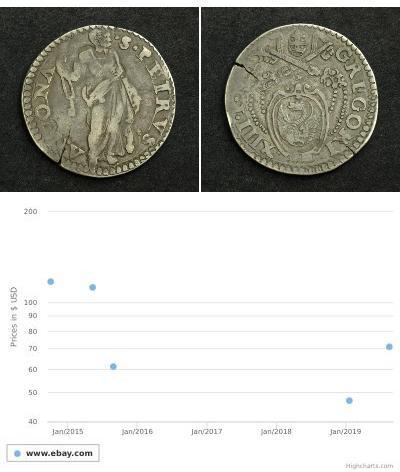400 Reis (Venduta per $224.0)
1790, Portugal/Brazil, Maria I. Rare Gold 400 Reis (Cruzado) Coin. Clipped XF!
Mint Date: 1771 Reference: KM-291. R! Denomination: 400 Reis (Cruzado) Mint Place: Lisabon (struck for circulation in Brazil!) Condition: Lightly clipped (reduced), otherwise a nice XF! Material: Gold (.917) Diameter: 13mm Weight: 0.91gm
Obverse: Cross of Jerusalem with four rosettes in fields. Date (1790) in legend above. Legend: + IN . HOC . SIGNO . VINCES + 1790 + Reverse: Crown above bove name of the King (+MARIA+/*I*) within wreath. Value (400) below.
Maria I (December 17, 1734 – March 20, 1816) was Queen of Portugal and the Algarves from 1777 until her death. Known as Maria the Pious, Maria the Mad, she was the first undisputed Queen regnant of Portugal. She was the eldest of the four daughters of Joseph I of Portugal and Mariana Victoria of Spain.
Born at the now destroyed Ribeira Palace in Lisbon, her full name was Infanta Maria Francisca Isabel Josefa Antónia Gertrudes Rita Joana de Portugal. On the day of her birth, her grandfather, King John V of Portugal, created her the Princess of Beira.
When her father, Joseph I, succeeded to the throne in 1750, Maria was declared his heiress and given the traditional title of Princess of Brazil, though not Duchess of Bragança.
Maria would grow up in a time when her fathers government and country was governed completely by the famous Marquis of Pombal. Her father would often retire to the Queluz National Palace which was later given to Maria and her husband. The Marquess took control of the government after the terrible 1755 Lisbon earthquake of November 1, 1755, in which around 100,000 people lost their lives; the palace of her birth was also destroyed in the disaster.
After the earthquake, her father was often uncomfortable at the thought of staying in enlcosed spaces and later had Claustrophobia. The king later had the Ajuda National Palace built away from the capital. The royal family would spend much time at the large palace and it was the birthplace of Maria's first child.
Infanta Maria married her uncle, Infante Peter of Portugal (July 5, 1717-May 25, 1786), who automatically became co-monarch as Peter III of Portugal when she was crowned Queen regnant, because a child had already been born from their marriage. The marriage took place on June 6, 1760 when the bride was 25 and the groom was 43. The couple, though very different age wise, would have a very happy marriage.
In 1777, she became the first Queen regnant of Portugal, and the Algarves, and the 26th (or 27th according to historian Alison Weiner) Portuguese monarch. Her husband became her co-monarch, known as Peter III. Despite the couple being the face of the Portuguese royals, the power was always to remain with Maria who was a good ruler prior to her madness.
Her first act as queen was to dismiss the popular prime minister, the Marquis of Pombal, who had broken the power of the reactionary aristocracy via the Tavora affair, partially because of Pombal's Enlightenment, anti-Jesuit policies. Noteworthy events of this period were Portugal's membership of the League of Armed Neutrality (July 1782) and the 1781 cession of Delagoa Bay from Austria to Portugal.
Queen Maria suffered from religious mania and melancholia. This acute mental illness (perhaps due to porphyria, which also may have attainted George III of the United Kingdom) made her incapable of handling state affairs after 1799. Her surviving son Prince John became regent for his widowed mother.
Her madness was first officially noticed in 1786 when Maria had to be carried back to her apartments in a state of delirium. The queen became increasingly worse. The year of 1786 saw her husband lose his life in May. Maria was devastated and forbade any court entertainments and according to a contemporary, the state festivities resembled religious ceremonies. When the Ajuda palace burnt down in 1795, the court was forced to move to Queluz where the ill queen would lay in her apartments all day and visitors would complain of terrible screams that would echo throughout the palace.
By 1799, the queen was deemed insane and her eldest surviving son, John, Prince of Brazil, took over the government and was named regent for his mother.
In 1801 the Spanish dictator Manuel de Godoy invaded Portugal with backing from Napoleon, but was forced to abandon the campaign in the same year. However the Treaty of Badajoz on June 6, 1801 forced Portugal to cede Olivenza and part of Guyana to Spain.
The refusal of the Portuguese government to join the Continental Blockade of Britain culminated in the 1807 Franco-Spanish invasion led by General Junot. At the urging of the British government, the entire Braganza dynasty fled to Brazil on November 29, 1807 and established a court in exile in Rio de Janeiro. Junot was appointed governor of Portugal pending Napoleon's decision on its ultimate fate.
In January 1808, Prince João and his court arrived in Salvador, where he signed a commercial regulation that opened commerce between Brazil and friendly nations, which in this case represented England. This important law broke the colonial pact that, until then, only allowed Brazil to maintain direct commercial relations with Portugal.
On August 1, 1808, the British General Arthur Wellesley (later Duke of Wellington) landed a British army in Lisbon and thus initiated the Peninsular War. Wellesley's initial victory over Junot at Vimeiro (August 21, 1808) was wiped out by his superiors in the Convention of Cintra (August 30, 1808). Nevertheless, Wellesley (now Lord Wellington) returned to Portugal on April 22, 1809 to recommence the campaign. Portuguese forces under British command distinguished themselves in the defence of the lines of Torres Vedras (1809-1810) and in the subsequent invasion of Spain and France.
In 1815, the regency government elevated Brazil to the status of a kingdom, and Maria I was proclaimed the Queen of the United Kingdom of Portugal, Brazil and the Algarves. When Napoleon was finally defeated in 1815, Maria and her family remained in Brazil.
The aged Queen died at a Carmelites convent in Rio de Janeiro in 1816 at the age of 81; the Prince Regent succeeded her as King John VI of Portugal and Brazil.
Only 1$ shipping for each additional coin purchased!

|
Postato da:
anonymous 2017-03-29 |
|
||
|
||
|
||
|
||
|
||

-600-300-MkEKX9IS7xQAAAFbFJ0qmhio.jpg)

-300-150-MkEKX9IS7xQAAAFbFJ0qmhio.jpg)
 Deutsch
Deutsch Русский
Русский Українська
Українська English
English Italiano
Italiano Français
Français Español
Español 汉语
汉语












